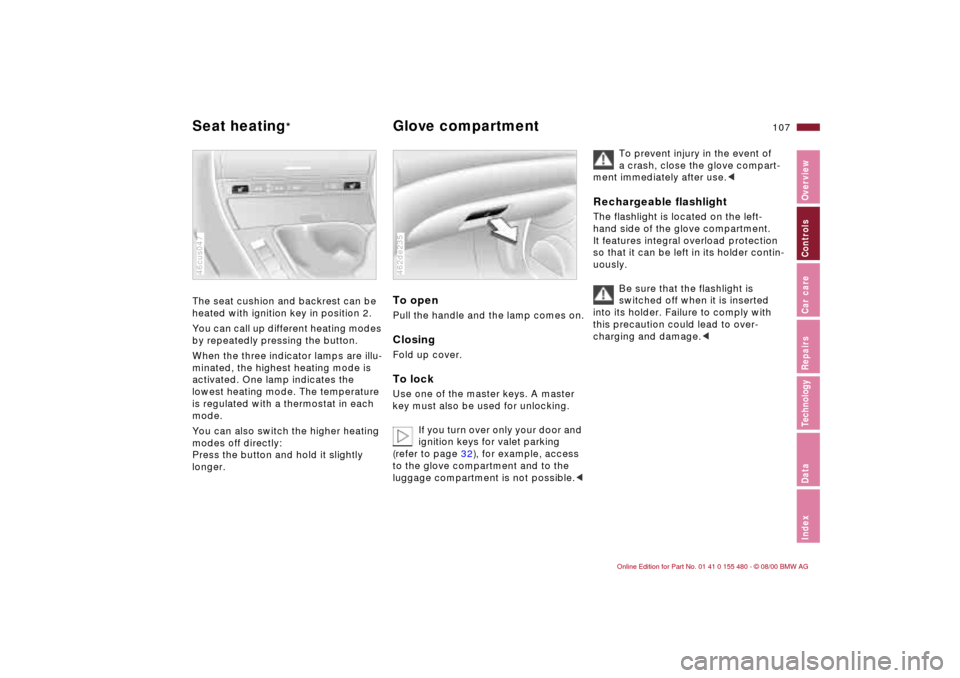2001 BMW 330Ci CONVERTIBLE charging
[x] Cancel search: chargingPage 20 of 215

20n
Indicator and warning lamps
Technology that monitors itself
Many of the systems of your BMW
monitor themselves automatically, both
during engine starts and while you are
driving. Indicator and warning lamps
that are identified by "
l
" are tested for
proper functioning whenever the igni-
tion key is turned. They each light up
once for different periods of time.
If a fault should occur in one of these
systems, the corresponding lamp does
not go out after the engine is started, or
it lights up while the vehicle is moving.
You will see how to react to this below.
Red: stop immediately
Battery charge
l
The battery is no longer being
charged. There is a malfunction
of the alternator V-belt or in the
charging circuit of the alternator. Please
contact the nearest BMW center.
If the V-belt is defective, do not
continue driving, otherwise, the
engine could be damaged due to over-
heating. If the V-belt is defective,
increased steering effort is also
required.
<
Engine oil pressure
l
Stop the vehicle immediately
and switch off the engine.
Check the engine oil and top off as
required. If the oil level is correct,
please contact the nearest BMW
center.
Do not continue driving. If you do
so, the engine could be damaged
because of inadequate lubrication.
<
Tire Pressure Control (RDC) l
In addition, an acoustic signal is
sounded: a tire failure has
occurred. Reduce vehicle speed imme-
diately to stop the vehicle. Avoid hard
brake applications. Do not oversteer.
For additional information, refer to
page 91.
Brake warning lamp l
If the lamp comes on when the
parking brake is not engaged:
check the brake fluid level. Before
driving further, be sure to read the
notes on pages 126 and 148.
Brake warning lamp for Cana-
dian models.
Page 70 of 215

70n
Starting the engine Switching off the engine Do not press the accelerator pedal
while starting the engine.
Do not actuate the starter for too
short a time, but do not actuate it
for more than approx. 20 seconds.
Release the ignition key immediately
when the engine starts.
Do not allow the engine to warm up by
leaving it running while the vehicle
remains stationary. Instead, begin
driving immediately at a moderate
engine speed.<
If the engine does not start on the first
attempt (if it is very hot or cold, for
instance):
>Press the accelerator pedal halfway
down while engaging the starter.
Cold starts at very low temperatures,
starting at about +57 (Ð156) and
at high altitudes over 3,300 ft
(1,000 meters):
>On the first start attempt, engage the
starter for a longer period (approx.
10 seconds).
>Press the accelerator pedal halfway
down while engaging the starter.
Engine idle speed is controlled by the
engine computer system. Increased
speeds at start-up are normal and
should decrease as the engine warms
up. If engine speed does not decrease,
service is required.
To prevent the battery from
discharging, always deactivate elec-
trical devices that are not in use. Switch
the ignition off when the vehicle is not
being driven.Turn the ignition key to position 1 or 0.
Do not remove the ignition key
while the vehicle is still moving.
If you did so, the steering lock would
engage when the steering wheel is
turned.
Whenever you leave the vehicle, always
remove the ignition key and lock the
steering wheel.
Vehicles with manual transmission:
Always apply the parking brake
when parking on slopes and inclined
surfaces, since placing the shift lever
in 1st gear or reverse may not provide
adequate resistance to rolling.
Vehicles with automatic transmission:
Place the selector lever in "Park."<
Page 107 of 215

107n
IndexDataTechnologyRepairsCar careControlsOverview
The seat cushion and backrest can be
heated with ignition key in position 2.
You can call up different heating modes
by repeatedly pressing the button.
When the three indicator lamps are illu-
minated, the highest heating mode is
activated. One lamp indicates the
lowest heating mode. The temperature
is regulated with a thermostat in each
mode.
You can also switch the higher heating
modes off directly:
Press the button and hold it slightly
longer.46cus047
To openPull the handle and the lamp comes on.ClosingFold up cover.To lockUse one of the master keys. A master
key must also be used for unlocking.
If you turn over only your door and
ignition keys for valet parking
(refer to page 32), for example, access
to the glove compartment and to the
luggage compartment is not possible.<462de235
To prevent injury in the event of
a crash, close the glove compart-
ment immediately after use.<
Rechargeable flashlightThe flashlight is located on the left-
hand side of the glove compartment.
It features integral overload protection
so that it can be left in its holder contin-
uously.
Be sure that the flashlight is
switched off when it is inserted
into its holder. Failure to comply with
this precaution could lead to over-
charging and damage.<
Seat heating
*
Glove compartment
Page 178 of 215

178n
BatteryRemoval and installation
Do not disconnect the battery
when the engine is running. If you
do so, the ensuing voltage surge will
damage the vehicle's onboard
electronics.
Do not make any modifications in the
wires to the positive terminal. If you do
so, the protective function of the safety
battery terminal is no longer ensured.
Repair and disposal must be performed
by trained technicians only.<
When removing the battery, disconnect
the cable on the negative terminal first,
then the cable on the positive terminal.
Loosen the center adjusting screw on
the battery retaining strap (use the
screwdriver included with the onboard
tool kit) and disconnect the strap.
When installing a battery, connect the
positive terminal first, then connect the
negative terminal.
When installing a battery, be sure
that it is mounted properly and that
the retaining bracket is installed with the
center adjustment screw. If this is not
done, the battery will not be adequately
secured in case of an accident.<
Charging the battery Charge the battery in the vehicle only
when the engine is not running.
Before doing any work on the
electrical system, be sure to
unclamp the cable from the battery's
negative terminal. Failure to do so can
result in short circuits, a fire or personal
injury.<
If you plan to park the vehicle for longer
than 4 weeks, disconnect the battery
from the vehicle electrical system by
disconnecting the cable at the negative
terminal. Have the battery recharged
with an appropriate battery charger.
If the vehicle is parked for more than
12 weeks, remove the battery, recharge
it and store it in a cool yet frost- and
dust-free area. During storage, have the
battery recharged every 3 months.
Also, recharge the battery before it is
reinstalled. If this is not done, the
battery will not be serviceable. Every
time the battery is discharged, espe-
cially over extended periods, its service
life is reduced.
Return used batteries to a
recycling center or your BMW
center. Maintain the battery in an
upright position for transport and
storage. Secure the battery to prevent it
from tilting during transport.<
Storage periods during which the
battery is disconnected are not
taken into consideration by the Service
Interval Display for changing the brake
fluid.
For this reason, be sure that the brake
fluid is changed every two years,
regardless of the information displayed.
Please read the pertinent information
on page 148.<
Page 204 of 215

Everything from A to Z
A
ABS (Antilock Brake System) 22,122
Accessories 6
Activated-charcoal filter 106,180
Adaptive Transmission Control (ATC) 73,188
Adding engine oil 145
Adding washer fluid 144,199
Adjusting backrest 52
Adjusting headrests 53
Adjusting the steering wheel 57
Adjusting the temperature 98,104
Adjusting thigh support 54
Air conditioner 96
Air distribution 98,104
Air nozzles 96,102
Air outlets 96,102
ventilation 96,102
Air pressure, tires 27,132
Air supply 98,105
Airbags 21,61 ,159 ,189
sitting properly with 62
Alarm system 42
Antenna 129
Antenna, Diversity 190 Antifreeze
147
radiator 127
Antilock Brake System (ABS) 22,122
Anti-theft alarm system 42
Aquaplaning 121,132
Armrest 110
ASC+T (Automatic Stability Control plus
Traction) 22,88
Ashtray front 111
rear 112
ATC (Adaptive Transmission Control) 73,188
Attach vacuum cleaner 112
AUC (Automatic recirculated-air
control) 105
Automatic car washes 151
Automatic climate control 102
remove window
condensation 105
Automatic cruise control 79
Automatic dimming, interior rearview mirror 58
Automatic recirculated-air control (AUC) 105
Automatic Stability Control plus Traction
(ASC+T) 22,88 Automatic transmission with
Steptronic 21,73
Automatic windshield washer 77
Average consumption 85
Average speed 86
Avoiding unwanted alarm 43
Axle loads 198
B
Backrest adjusting 52
locking 21,55
releasing 55
Backup lamps 72
bulb replacement 169
Battery 176,200
capacity 200
charge current 20,176
charging 178
discharged 183
removal and
installation 178
Belts 60
Beverage holder 111
Blower 98,105
BMW High Performance Synthetic Oils 146
BMW Maintenance System 150 BMW sports seat
54
Bore 196
Brake fluid 148
Brake hydraulic system 20
Brake lamps, bulb replacement 169
Brake pads 22,126
Brake system 126
Brakes 125
malfunctions 126
Break-in procedures 120
Bulb replacement 166
C
California Proposition 65 Warning 161
Capacities 199
Car Memory 59
Car radio 129
reception 129,190
refer also to the Radio
Owner's Manual
Car washes 151
Care convertible top 157
exterior 152
interior 154
leather upholstery 155
rubber seals and
components 127
Page 210 of 215

Owner service procedures
A
Activated-charcoal filter 180
Adding brake fluid 148
Adding engine coolant 148
Adding engine oil 145
Air pressure, checking 27
Antifreeze 147
Avoiding unwanted alarm 43
B
Backup lamps, bulb replacement 169
Battery add distilled water 177
charging 178
Brake faults 126
Brake fluid, adding 148
Brake lamps, bulb replacement 169
Brakes, brake faults 126
C
Changing a tire 173
Changing a wheel 173
Changing the
microfilter 180 Checking air pressure
27
Checking engine oil level 145
D
Defrost setting 100,105
Defrosting the windows 100,105
Difficult steering 129
Doors, emergency actuation 34
E
Electrical accessories, failure 179
Emergency operation convertible top 181
doors 34
fuel filler door 180
Engine coolant, adding 148
Engine oil add 145
level checking 145
quality 146
specifications 146
viscosity 146
Eyelets, towing 184
F
False alarm, avoiding 43
First-aid kit 25
Flat tire 173
Fog lamps, bulb replacement 169
Footwell lamps, bulb replacement 172
Fuel filler door manual release after
electrical fault 180
Fuses, replacing 179
G
Glove compartment lamp, bulb replacement 172
H
Hazard warning flashers 25
Hazard warning triangle 25
Headlamp cover, care 167
High beam headlamps, bulb replacement 167
Hood release 140
I
Indicator lamps 20
Inflation pressures 27,132 Interior lamps, bulb
replacement 171
Interior motion sensor, switching off 43
J
Jack 173
L
License plate lamp, bulb replacement 171
Low beam headlamps, bulb replacement 167
Luggage compartment emergency release 39
Luggage compartment lamps, bulb
replacement 172
Luggage compartment lid emergency release 39
M
Maintenance 150
Microfilter, changing 180
Motion sensor, switching off 43